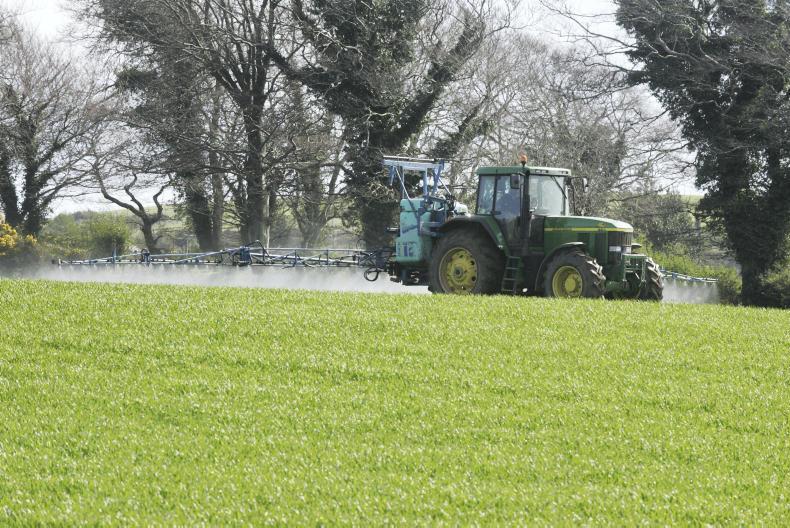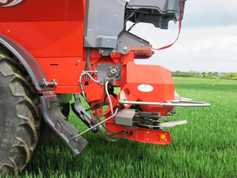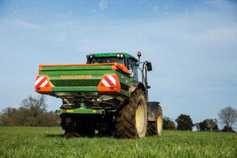When we think of weeds in grassland, the first weeds that comes to mind are usually docks, thistles and to a lesser extent buttercups. Of these, docks are by far the biggest blight of productive grassland.
Dock infestations are a common sight across the country, but docks thrive on soils high in potassium so they are more of a problem on rich, fertile soils. Docks shade out grass and compete with it for soil nutrients. The problem with docks and other weeds is that cattle don’t graze them and they have a poor nutritive value when cut for silage.
A handy way to measure infestation rates is to mark out a representative area of a field 5m by 7m and count the number of docks within this area. Each dock is 1%, so 10 docks in the rectangle means there is a 10% infestation rate, therefore 10% less grass across the affected area.
There are a couple of myths around docks. Some people find that reseeding creates a dock problem and blame contaminated grass seeds as being the source. This is not the case. There are millions of dormant dock seeds in the soil and the act of reseeding and creating a seedbed gives these dock seeds an opportunity to germinate.
Some people say that slurry is the cause of dock infestations. The slurry itself is not very likely to contain viable dock seeds. Firstly, dock seeds are usually not viable at the time first-cut silage is taken. Secondly, dock seeds cannot survive low pH conditions so pit silage, which is low in pH, would probably kill the dock seeds. They are also unlikely to survive the passage through the cows’ rumen.
However, silage fields are often more prone to docks than grazing fields. But this is more than likely due to the fact that silage swards are more open than continuously grazed swards. Where docks are present and where docks go to seed, they will germinate easier in more open swards. Hence, silage fields are often where docks are most prevalent.
Reseeding
Docks have a tap root which can be up to 1m long underground. This makes it extremely difficult to kill with chemicals. The best time to control docks is when they are seedlings, before the tap root is formed. So after reseeding is the best time to spray and achieve a total kill.
Spraying off the existing sward is an important control mechanism. While the grass will turn yellow five or six days after spraying with glyphosate, it should be left three weeks before cultivating for the chemical to work its way down to the deep dock roots.
However, it is seldom in an Irish context that three weeks are left between spraying and cultivating unless the weather breaks in the interim. Most farmers will cultivate earlier than three weeks but the longer the period, the better the kill.
While the spray to burn off the existing sward is important, the post-emergence spray is critical. As mentioned, there are millions upon millions of dormant weed seeds in the soil and after cultivating and creating a seedbed, they have as much of a chance of emergence as the grass seeds have.
The majority of these weeds are annuals, and won’t survive past one season. Nevertheless, their presence will adversely affect the establishment of the new grass sward. Weeds such as chickweed can smother the new seeds.
But of much more importance are the dock seedlings as once these are established it is difficult to kill them. Sometimes, fragments of dock roots can re-establish and start to grow again so the post-emergence spray will help to kill these off when they are weak and only becoming established.
Clover
A key consideration when spraying reseeds for weeds is what to do with clover. Clover-safe sprays are available and offer good control over the docks but the timing of spraying is even more critical than with non-clover-safe sprays. The best results for all sprays are achieved when the correct rate is used and when spraying the docks at the right stage and in the right conditions, but this is even more important when controlling docks with clover-safe sprays.
With recent Teagasc trial results showing the benefits of clover, most farmers will be anxious to protect the clover in the new reseeds. If there is heavy dock infestation in the field, some farmers will buy the grass seed without clover and use non-clover-safe sprays, which are cheaper and some say more effective at controlling docks. They will then over-sow clover at a later date.
The key thing when spraying reseeds is to get the timing right. Ideally, grass should be at the two- to three-leaf stage before spraying. This is before the first grazing and when the seedling docks and chickweed have emerged.
Long-term control of docks in established swards is much more difficult. This is because of the tap root of the dock which is hard to kill. Effective spraying should dramatically reduce the number of docks for at least two seasons, but dock numbers will probably increase again thereafter. Effectively, near permanent control is achieved when sprayed as seedlings, but only temporary control is achieved when established.
When spraying established swards for docks, two things are critical – timing and volume of water. The docks should be sprayed at the rosette stage, or when they are actively growing and measure about 8in wide. The time of the year is less critical as docks that have been cut previously can still be at the right stage in the autumn. The advantages of spring-spraying is that the field is clean for the rest of the year.
The amount of water used is important also. The general recommendation for most sprays is to use 300l/ha to 400l/ha of water when spraying for grassland weeds. Grass is a dense crop so the more water used the more leaf area the chemical will be in contact with. Follow the instructions on the pack regarding when it is safe to graze and harvest grass on sprayed fields. Some sprays do not recommend any silage or hay to be cut in the calendar year of treatment. So if it is sprayed in May, it should not be cut for silage until the following year but if it is sprayed in August it may be cut for silage the following year.
Spot-spraying with a knapsack is another option where the areas are small. Only some chemicals for weeds in grasslands are suitable for knapsack-spraying so check with your retailer before purchasing.
Remember, you must be registered and trained to apply any spray and all chemical use must be logged as part of cross-compliance regulations.
The best time to kill docks is after reseeding when they are seedlings.Effective dock control in established grassland is possible but it does not provide long-term control.Use only clover-safe sprays if you want to protect clover.Spray established docks when they are at the rosette stage and use high volumes of water.
When we think of weeds in grassland, the first weeds that comes to mind are usually docks, thistles and to a lesser extent buttercups. Of these, docks are by far the biggest blight of productive grassland.
Dock infestations are a common sight across the country, but docks thrive on soils high in potassium so they are more of a problem on rich, fertile soils. Docks shade out grass and compete with it for soil nutrients. The problem with docks and other weeds is that cattle don’t graze them and they have a poor nutritive value when cut for silage.
A handy way to measure infestation rates is to mark out a representative area of a field 5m by 7m and count the number of docks within this area. Each dock is 1%, so 10 docks in the rectangle means there is a 10% infestation rate, therefore 10% less grass across the affected area.
There are a couple of myths around docks. Some people find that reseeding creates a dock problem and blame contaminated grass seeds as being the source. This is not the case. There are millions of dormant dock seeds in the soil and the act of reseeding and creating a seedbed gives these dock seeds an opportunity to germinate.
Some people say that slurry is the cause of dock infestations. The slurry itself is not very likely to contain viable dock seeds. Firstly, dock seeds are usually not viable at the time first-cut silage is taken. Secondly, dock seeds cannot survive low pH conditions so pit silage, which is low in pH, would probably kill the dock seeds. They are also unlikely to survive the passage through the cows’ rumen.
However, silage fields are often more prone to docks than grazing fields. But this is more than likely due to the fact that silage swards are more open than continuously grazed swards. Where docks are present and where docks go to seed, they will germinate easier in more open swards. Hence, silage fields are often where docks are most prevalent.
Reseeding
Docks have a tap root which can be up to 1m long underground. This makes it extremely difficult to kill with chemicals. The best time to control docks is when they are seedlings, before the tap root is formed. So after reseeding is the best time to spray and achieve a total kill.
Spraying off the existing sward is an important control mechanism. While the grass will turn yellow five or six days after spraying with glyphosate, it should be left three weeks before cultivating for the chemical to work its way down to the deep dock roots.
However, it is seldom in an Irish context that three weeks are left between spraying and cultivating unless the weather breaks in the interim. Most farmers will cultivate earlier than three weeks but the longer the period, the better the kill.
While the spray to burn off the existing sward is important, the post-emergence spray is critical. As mentioned, there are millions upon millions of dormant weed seeds in the soil and after cultivating and creating a seedbed, they have as much of a chance of emergence as the grass seeds have.
The majority of these weeds are annuals, and won’t survive past one season. Nevertheless, their presence will adversely affect the establishment of the new grass sward. Weeds such as chickweed can smother the new seeds.
But of much more importance are the dock seedlings as once these are established it is difficult to kill them. Sometimes, fragments of dock roots can re-establish and start to grow again so the post-emergence spray will help to kill these off when they are weak and only becoming established.
Clover
A key consideration when spraying reseeds for weeds is what to do with clover. Clover-safe sprays are available and offer good control over the docks but the timing of spraying is even more critical than with non-clover-safe sprays. The best results for all sprays are achieved when the correct rate is used and when spraying the docks at the right stage and in the right conditions, but this is even more important when controlling docks with clover-safe sprays.
With recent Teagasc trial results showing the benefits of clover, most farmers will be anxious to protect the clover in the new reseeds. If there is heavy dock infestation in the field, some farmers will buy the grass seed without clover and use non-clover-safe sprays, which are cheaper and some say more effective at controlling docks. They will then over-sow clover at a later date.
The key thing when spraying reseeds is to get the timing right. Ideally, grass should be at the two- to three-leaf stage before spraying. This is before the first grazing and when the seedling docks and chickweed have emerged.
Long-term control of docks in established swards is much more difficult. This is because of the tap root of the dock which is hard to kill. Effective spraying should dramatically reduce the number of docks for at least two seasons, but dock numbers will probably increase again thereafter. Effectively, near permanent control is achieved when sprayed as seedlings, but only temporary control is achieved when established.
When spraying established swards for docks, two things are critical – timing and volume of water. The docks should be sprayed at the rosette stage, or when they are actively growing and measure about 8in wide. The time of the year is less critical as docks that have been cut previously can still be at the right stage in the autumn. The advantages of spring-spraying is that the field is clean for the rest of the year.
The amount of water used is important also. The general recommendation for most sprays is to use 300l/ha to 400l/ha of water when spraying for grassland weeds. Grass is a dense crop so the more water used the more leaf area the chemical will be in contact with. Follow the instructions on the pack regarding when it is safe to graze and harvest grass on sprayed fields. Some sprays do not recommend any silage or hay to be cut in the calendar year of treatment. So if it is sprayed in May, it should not be cut for silage until the following year but if it is sprayed in August it may be cut for silage the following year.
Spot-spraying with a knapsack is another option where the areas are small. Only some chemicals for weeds in grasslands are suitable for knapsack-spraying so check with your retailer before purchasing.
Remember, you must be registered and trained to apply any spray and all chemical use must be logged as part of cross-compliance regulations.
The best time to kill docks is after reseeding when they are seedlings.Effective dock control in established grassland is possible but it does not provide long-term control.Use only clover-safe sprays if you want to protect clover.Spray established docks when they are at the rosette stage and use high volumes of water. 





 This is a subscriber-only article
This is a subscriber-only article










SHARING OPTIONS: